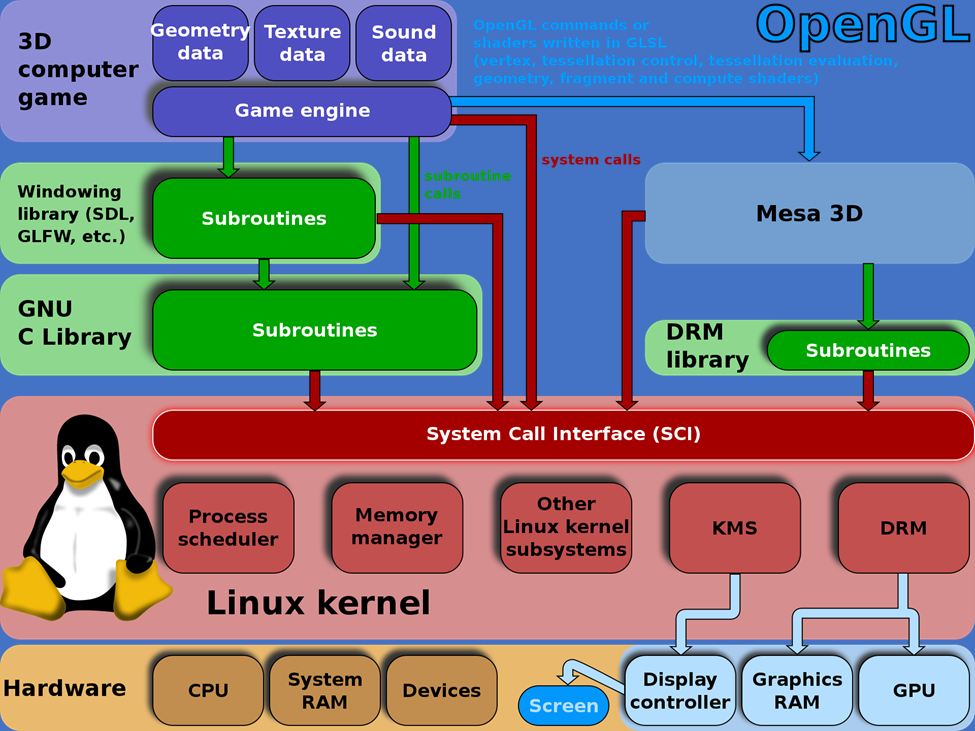
Mesa is an open-source graphics library that translates graphics API specifications into hardware drivers for GPUs. It is crucial for Intel and AMD graphics drivers, while Nvidia uses proprietary drivers. The community-driven Nouveau project aims to create a Mesa Nvidia driver. Mesa is widely adopted and serves as the primary pathway for graphics rendering in applications like games and display servers. Mesa recently achieved a 100% pass rate for emulated ray tracing with its Radeon RADV driver. The upcoming Mesa 23.2 release will enable RADV RT support by default for compatible GPUs, including older AMD GPUs. The latest code consistently achieves a perfect pass rate in Vulkan ray-tracing tests.
The Mesa 3D Graphics Library, also simply known as Mesa, or Mesa3D, is an open-source compilation of OpenGL, Vulkan, and other graphics API specifications. The Mesa organization translates those specifications to specific hardware drivers for various GPUs.
Mesa, an essential component for graphics processing, primarily serves as the backbone for two prominent graphics drivers developed and supported by Intel and AMD for their respective hardware. AMD actively promotes their Mesa drivers, Radeon and RadeonSI, as superior alternatives to their deprecated AMD Catalyst driver, while Intel exclusively supports the Mesa driver. In contrast, proprietary graphics drivers like Nvidia’s GeForce driver and Catalyst completely replace Mesa by implementing their own graphics API.
An open-source initiative known as Nouveau aims to create a Mesa Nvidia driver primarily driven by the community. This collaborative effort seeks to provide an alternative for Nvidia users within the Mesa framework.
Mesa’s significance extends beyond 3D applications such as games. Modern display servers like X.org’s Glamor or Wayland’s Weston rely on OpenGL/EGL, making Mesa the primary pathway for graphics rendering in most scenarios.
The development and hosting of Mesa are managed by freedesktop.org. Brian Paul, who initiated the project in August 1993, remains actively involved to this day. Mesa has gained widespread adoption and incorporates contributions from individuals and corporations across the globe, including major graphics hardware manufacturers associated with the Khronos Group, which oversees the OpenGL specification. Additionally, crowdfunding efforts have played a partial role in driving Mesa’s development, particularly in the Linux ecosystem.
According to Mesa’s recent announcement, the Radeon RADV driver’s emulated ray-tracing functionality has achieved a perfect 100% pass rate. The RADV driver, specifically designed for Radeon Vulkan, has made significant progress in supporting native hardware ray tracing on RDNA2 and RDNA3 graphics cards over the past few months. In the upcoming Mesa 23.2 release, RADV RT support will be enabled by default for all compatible GPUs. Additionally, RADV also offers emulated ray-tracing support for older generations of AMD GPUs, and as of today, it has successfully achieved a flawless pass rate of 100%.
Based on the Vulkan conformance test suite (CTS) assessments for Vulkan ray tracing, the latest code integrated into Mesa 23.2-devel demonstrates that the optional emulated RT path consistently achieves a perfect pass rate of 100%.
Right now, it isn’t clear if that emulated-RT-by-default will be merged, though some objections have been raised on how it could adversely impact the user experience for those on older Radeon GPUs when moving to newer Mesa and then suddenly finding some games running very slow if the game suddenly starts trying to utilize ray tracing. Mesa says it can be easily enabled by those on RDNA1 hardware and older.